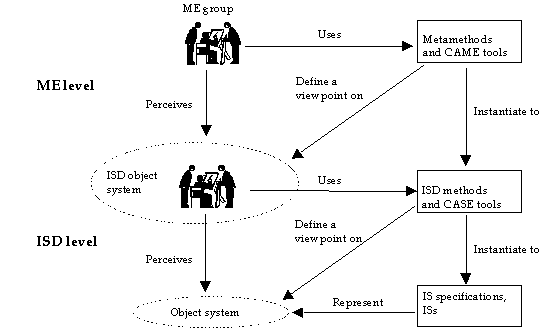3.1 Defining method engineering
The need for systematic principles to develop
situation-specific methods has led to the emergence of method engineering
(Bergstra et al. 1985, Kumar and Welke 1992). In a similar vein to ISD, we
define method engineering (ME) as a change process taken with
respect to an ISD object system in a set of ISD environments by a
method engineering group using a metamethod and
supporting tools to achieve or maintain methods for ISD. Figure
3-1 illustrates the relationship between method engineering and ISD. In the
following we describe this relationship and define ME in more detail by
explaining each italicized key concept of the definition.
FIGURE 3-1 Method engineering and information systems
development.
Both ISD and ME are social processes, in which a number of
people act and have an interest. At the level of ME, method engineers
form a group which perceives the current state of ISD. They are in charge of
defining, choosing, modeling and producing method specifications and customizing
tools in a similar way to the ISD group creating IS specifications and
implementing them. This also distinguishes method engineers from researchers,
since the latter are more interested in studying methods (even with metamodels
and metamethods) rather than implementing methods for the organization. Method
engineers can therefore be considered as developers of ISs for ISD. Often they
can be the same group as those carrying out ISD. Furthermore, because the
end-users of ISD applications include ISD professionals, they can be expected to
be more aware of technical possibilities and thus more demanding than end-users
of other type of ISs. This partly explains the importance of stakeholder value
based ME (Kumar and Welke 1984, 1992) which emphasizes the role of method users
in ME efforts. By stakeholders we mean people who have an interest in method
development and method use. These include method experts, tool experts, managers
of ISD, IS developers, and IS users. Studies in ME, however, have so far
concentrated on developing concepts and principles for ME (Brinkkemper 1990,
Heym and Österle 1992), whereas only a few discussions (see e.g. Bubenko
1988, Tagg 1990, Nissen 1996) study the role of method engineers and other
stakeholders.
Both ISD and ME aim to deliver an IS, often a computerized
one. Method engineers carry out a change process resulting in methods and
tools which support some tasks of ISD. An example of such a system is a CASE
tool customized to support a specific method. During the ME process, a method,
or its part, is created, modified, and removed to achieve or improve
situation-specific methods. Thus, the goal of ME is to improve ISD by providing
better methods and supporting tools. In the ME literature situation-specific
needs are understood as a closer relationship between the method and the
characteristics of ISD situations (Vlasblom et al. 1995), required problem
solving capabilities (Punter and Lemmen 1996), or stakeholders’ values
(Kumar and Welke 1984, 1992). The “better” in turn implies that the
constructed method can be compared in detail with other alternative
situation-bound methods or their parts. Each of these approaches to achieve the
objectives related to methods is discussed in more detail in the next
section.
Both ISD and ME can be supported by methods. To
differentiate methods between these two levels we use the prefix meta to denote
methods and tools at the metalevel, e.g. metamethods, metamodeling and metaCASE.
This distinction is also important for this thesis since we focus on studying ME
rather than ISD. Like ISD methods, metamethods can be viewed through the
taxonomy of method knowledge (cf. Section 2.2). First, a conceptual structure of
a metamethod includes concepts specific for engineering ISD methods. Second, the
specifications of an ISD method are communicated with a metamodeling notation.
Together, the metamodeling concepts and notation form a metamodeling language.
As in the term metamethod, the prefix “meta” means that the
metamodeling language represents parts of the ISD method in terms of a model of
a method, i.e. a metamodel (Brinkkemper 1990, van Gigch 1991). Third, a
metamethod includes procedures for metamodeling and constructing methods, and a
set of criteria to meet the situational requirements of methods. However, other
types of knowledge necessary to carry out ME supported by a metamethod, like the
participation and different roles, have been studied far less in ME literature
(cf. Tolvanen et al. 1996).
Like ISD, ME too can be supported by tools. This symmetry
has introduced the term CAME, Computer Aided Methodology Engineering (Kumar and
Welke 1992) to highlight the role of tools in ME. In this thesis we regard the
supporting tools of method engineers as metaCASE tools (Kelly 1997), also
called metasystems (Sorenson et al. 1988), or CASE shells (Bubenko 1988). These
tools offer facilities to tailor CASE tools to specific methods.
Finally, an ME process is not performed just once because
the ISD environment changes. This is emphasized in the definition by the
inclusion of the maintenance of methods into ME. The environment also includes
stakeholders, who have different, changing, or even conflicting objectives. For
example, developers can require methods which minimize errors in a developed IS,
managers want the method to improve productivity, and IS users want
understandable design documents. The changes and experiences of the
method’s use raise new requirements for methods and their tool support. As
a result, a method constructed at one point of time is not necessarily
applicable in the next similar project, or even later in the same project.
Therefore, methods have to be maintained and revised. This observation leads to
an evolution-based approach where methods are developed incrementally for local
and changing needs.





